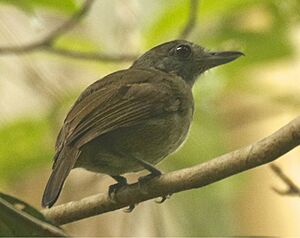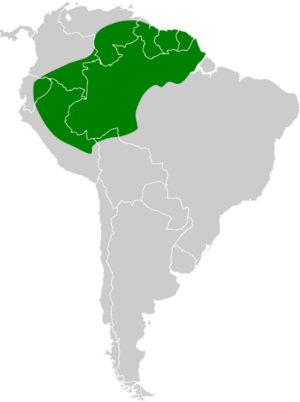Mouse-colored antshrike facts for kids
Quick facts for kids Mouse-colored antshrike |
|
|---|---|
 |
|
| Sacha Lodge - Ecuador | |
| Conservation status | |
| Scientific classification | |
| Genus: |
Thamnophilus
|
| Species: |
murinus
|
 |
|
The mouse-colored antshrike (Thamnophilus murinus) is a cool bird that lives in the forests of South America. It's part of a bird family called "typical antbirds." You can find this bird in many countries like Bolivia, Brazil, Colombia, Ecuador, French Guiana, Guyana, Peru, Suriname, and Venezuela.
Contents
About This Bird's Name
The mouse-colored antshrike got its name from two English bird experts, Philip Sclater and Osbert Salvin, way back in 1868. They gave it the scientific name Thamnophilus murinus. This bird is like a close cousin to another bird called the plain-winged antshrike.
There are three slightly different types, or subspecies, of the mouse-colored antshrike. They are T. m. murinus, T. canipennis, and T. cayennensis.
What Does It Look Like?
The mouse-colored antshrike is about 13 to 14 cm (5.1 to 5.5 in) long. That's about the length of a small ruler. It weighs around 17 to 20 g (0.60 to 0.71 oz), which is like a few quarters.
These birds have strong beaks with a hook, similar to a shrike bird. Boys and girls of this bird look quite different from each other.
Male Antshrikes
Male mouse-colored antshrikes usually have gray feathers on their back. They have a hidden white patch between their shoulders. Their wings are dark yellowish-brown. In some areas, their wings might look a bit reddish. Their tail is brownish-black and gray with white tips. Their chest and belly are a lighter gray, and sometimes their belly center is white.
Female Antshrikes
Female mouse-colored antshrikes have a dull reddish-brown head. Their back feathers are olive-brown. Their wings are brown, and like the males, can be more reddish in the east. Their wing and flight feathers have buffy white tips. Their tail is warm brown with thin white tips. Their belly is pale gray with a hint of olive or yellowish-brown.
Both male and female antshrikes have gray or brown eyes.
Where Do They Live?
The mouse-colored antshrike lives in different parts of South America.
Specific Locations
- The T. m. murinus subspecies lives in parts of Colombia, Venezuela, Guyana, Suriname, and Brazil.
- The T. cayennensis subspecies is found in French Guiana and northeastern Brazil.
- The T. canipennis subspecies lives in southeastern Colombia, Ecuador, Peru, and northern Bolivia. It also extends into western Brazil.
Their Home Environment
These birds mostly live in lowland terra firme forests. They also like white-sand evergreen forests. They prefer to stay in the middle or lower parts of the forest. You can find them deep inside the forest or sometimes at its edges. They usually live in areas below 400 m (1,300 ft) in Colombia. In Peru, they can be found up to 1,200 m (3,900 ft) high.
How They Live
Movement
Mouse-colored antshrikes usually stay in the same area all year long. They don't migrate far away.
Feeding Habits
These birds mainly eat insects and other small creatures like arthropods. They usually look for food alone or in pairs. Sometimes, they might join groups of different bird species feeding together.
They often search for food between 5 and 10 m (15 and 35 ft) above the ground in tall forests. But they can go as high as 25 m (80 ft) or as low as 2 m (5 ft). In shorter forests, they usually feed between 3 and 8 m (10 and 25 ft) high. They hop among branches, picking up prey from leaves, stems, and vines. They might also make short flights or hover to catch food. Occasionally, they follow army ant swarms to catch insects trying to escape the ants.
Reproduction
We don't know exactly when the mouse-colored antshrike's breeding season is. There are records of them breeding in French Guiana in January, May, and September. In Brazil, they seem to breed from August to November.
Their nest is shaped like a cup. It's made mostly from fungal parts, with dried leaves and twigs on the outside. The nest usually hangs from a branch fork about 2 to 3 m (7 to 10 ft) above the ground. They typically lay two eggs. Both parents help to incubate the eggs during the day. Other details about their parenting are still a mystery.
Vocalization
The mouse-colored antshrike's song is a series of about 15 similar notes that get a little faster. It sounds like "arr arr arr-arr wee'AWR". Their main call is "nasal and abrupt." They also make "a flat, raspy whine" and "a clear note that becomes a raspy growl."
Conservation Status
The IUCN (International Union for Conservation of Nature) says the mouse-colored antshrike is of "Least Concern." This means it's not currently in danger of disappearing. It lives across a very large area. We don't know exactly how many there are, but their numbers seem to be going down. No big threats have been found right now.
These birds are quite common in most places they live. However, they are less common in Ecuador, Venezuela, and Peru. There are many protected forest areas where they live. But they can be sensitive to selective logging, which is when only certain trees are cut down.


